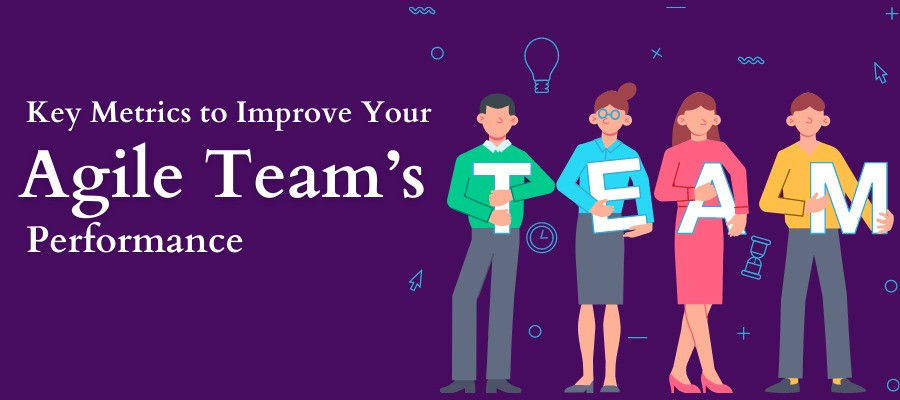Key Metrics to Improve Your Agile Team’s Performance

Agile methodologies, such as Scrum, have become increasingly popular in recent years for their ability to deliver value to customers quickly and efficiently. A key aspect of Agile methodologies is using key metrics to continuously measure and improve the Agile team's performance. This article will discuss the key metrics that Agile teams should monitor to improve their performance.
To be successful in an Agile environment, Scrum Masters and Product Owners need to be certified. A Certified Scrum Master (CSM) is a professional who has demonstrated a deep understanding of Scrum and has the skills necessary to guide an Agile team toward success. A Certified Scrum Product Owner (CSPO) is a professional responsible for ensuring that the Agile team delivers value to the customer. The Scrum Alliance, a leading Agile and Scrum education organization, offers both certifications.
1. Velocity
Velocity measures the amount of work the Agile team can complete in a sprint. This metric is important because it helps the team understand how much work they can realistically commit to in a sprint and helps the Product Owner prioritize the backlog.
Velocity is a valuable metric for Agile teams because it provides a clear picture of their capacity. If the velocity is consistently low, it may indicate that the team is facing challenges preventing them from being productive. On the other hand, if the velocity is consistently high, it may indicate that the team is productive and motivated. In either case, monitoring velocity is an essential part of continuous improvement.
2. Sprint Burn-Down Charts
A sprint burn-down chart is a visual representation of the amount of work remaining in a sprint. This metric is important because it helps the Agile team understand their progress and identify areas where they can improve. So it’s good practice for Agile teams!
Sprint burn-down charts are helpful for Agile teams because they provide a clear picture of the team's progress. If the sprint burn-down chart shows that the team is consistently behind schedule, it may indicate that the team is facing challenges preventing them from being productive. On the other hand, if the sprint burn-down chart shows that the team is consistently ahead of schedule, it may indicate that the team is productive and motivated. In either case, monitoring sprint burn-down charts is essential for continuous improvement.
3. Lead Time
One of the key metrics in Agile project management is lead time. It measures the elapsed time from when a User Story or Product Feature is added to the Product Backlog to when it gets delivered to the end user. This metric determines the team's ability to deliver value quickly and efficiently. It provides valuable insights into the team's performance and helps identify bottlenecks impacting their ability to deliver quickly.
For example, a consistently long lead time may indicate that the team is facing obstacles, such as poor collaboration or a lack of resources, hindering their ability to deliver value promptly. On the other hand, a consistently short lead time indicates that the team is performing well, delivering value quickly, and providing a better user experience. By monitoring lead time, Agile teams can continuously improve their processes and better serve the needs of their customers.
4. Defect Density
Another essential metric in Agile project management is defect density, which measures the code's number of defects or errors. This metric is essential in evaluating the quality of the team's work and helps identify areas for improvement. By monitoring defect density, the team can stay on top of the quality of their code and take proactive steps to eliminate defects before they cause problems.
If the defect density is consistently high, it may indicate that the team is facing challenges, such as poor testing practices or a lack of attention to detail, preventing them from delivering high-quality work. On the other hand, a consistently low defect density is a sign of a well-functioning team following best practices and delivering high-quality work. In this way, monitoring defect density is crucial for continuous improvement and maintaining the high standards of the Agile team.
Summarizing The Key Metrics:
In conclusion, there are several key metrics that Agile teams should be monitoring to improve their performance. These metrics include velocity, sprint burn-down charts, lead time, and defect density. By monitoring these metrics, Agile teams can better understand their performance, identify areas for improvement, and continuously improve their work.
Agile training and Scrum training, including workshops and certification courses, are essential to continuous improvement for Agile practitioners and beginners alike. PremierAgile offers comprehensive Agile and Scrum training, including education and coaching, to help organizations and individuals transform their Agile practices and achieve success. Whether you are an Agile Product Owner, Agile Developers, or part of an Agile Scrum team, investing in education and learning can help you continuously improve and achieve better results.



